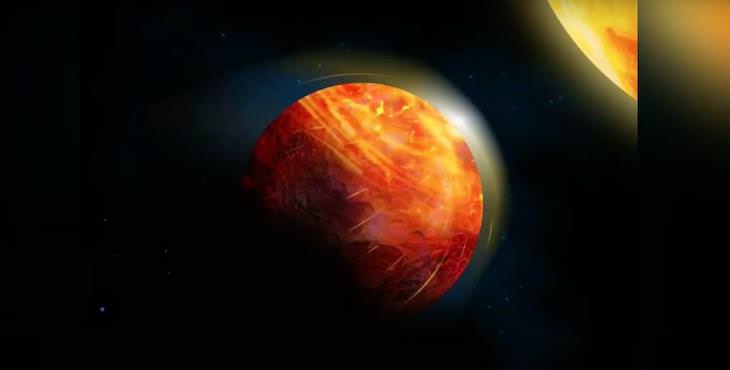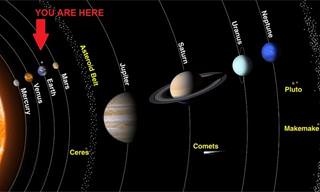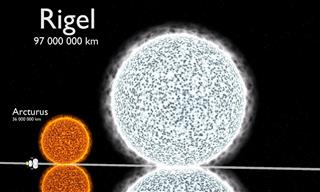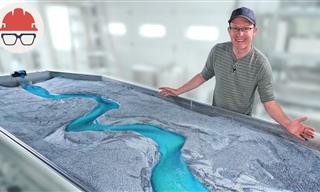
If life on Earth sounded like a dystopia at certain points this year, it’s nothing when compared to the conditions on K2-142b, an exoplanet (a planet which orbits around another star, rather than the Sun) discovered in 2018. While astronomers have been aware of K2-142b for 2 years now, an extensive scientific study of this newfound exoplanet has only recently been published and the findings are quite striking - in fact, K2-141b is one of the most extreme places ever discovered.
Because K2-141b orbits its star so closely, it is defined as a “lava planet”, meaning the majority of it is composed of lava oceans. However, there is something else that sets this particular planet apart and makes it so unusual, according to researchers from McGill University, York University, and the Indian Institute of Science Education. The Earth-sized K2-141b appears to have a surface, ocean, and atmosphere all made of the same ingredient: rock. And this makes for some pretty bizarre weather conditions.

It appears that two-thirds of the planet faces constant daylight, which is owed to the fact that it's gravitationally locked in place thanks to its proximity to its host star. The other side faces never-ending darkness. While the temperature on the night side is agonizingly cold - 200°C (-328°F) - the scorching hot dayside can reach a shocking temperature of 3000°C (5432 F°). It's hot enough to not only melt rocks but also to vaporize them.
The vapor then turns into precipitation, just like the water cycle on Earth. The rock vapor rises up into the atmosphere and is then swept up by high winds over to the night side of K2-141b. This rock vapor then returns to the surface in the form of rain. The result is, well, a rain of rocks that falls into the 60-mile-deep magma ocean, which in turn, flows to the bright side, and the cycle begins all over again.

Only this cycle is not as stable as the one here on Earth. The flow of the lava ocean from one side to the other is slower, and researchers predict that over time, it will alter the shape and the atmosphere of the exoplanet completely.
"All rocky planets, including Earth, started off as molten worlds but then rapidly cooled and solidified. Lava planets give us a rare glimpse at this stage of planetary evolution," said the study’s co-author Nicolas Cowan.
The team is currently working on validating those predictions using data from the Spitzer Space Telescope. Once the new James Webb Space Telescope is launched in 2021, they should be able to further solidify their predictions regarding K2-141b’s atmospheric cycle. There is no doubt that the more we discover about the universe, the more we realize how extraordinary nature is, and the unexpected potential it holds.
If you found this article interesting, pass it on and share it with family and friends

The Link Between Excessive TV Watching & Cognitive Decline
Three recent studies find that the more TV you watch in your 40s to 60s, the greater your risk of brain health issues later in life. What can you do about it?

Ancient People Knew About Astronomy Some 40,000 Years Ago!
A pair of British researchers recently decided to turn their attention to ancient art. What they found was remarkable - 40,000-year-old astronomical knowledge!
 14:01
14:01
Your Quick Guide to the Fascinating World of Astrophysics
Curious about astrophysics? An astrophysicist provides answers to some of the most intriguing questions posed on the internet.

Forget Apples! It's an Egg a Day That Keeps the Doc Away...
According to new research, it could actually be an egg a day that keeps the doctor away.Find out more here!
 8:23
8:23
Inspiring: Man Breaks World Record for Space Jump
Watch Felix Baumgartner break the world record for the longest space jump in history!

Lower Your Blood Pressure Naturally by Eating Watermelon
Watermelon is not only refreshing and delicious on a warm day - it has also been linked to lowering blood pressure levels.

This Humanoid Robot May Join the Workforce Very Soon...
Meet Digit – a bipedal robot that's ready to join human workers at warehouses around the world as early as 2024.

First US Embryo to be 'Edited'; Rise of Genetic Changes!
Could the first human embryos be genetically modified?
 13:55
13:55
The Disappearing Computer: Revolution on a Personal Scale
What happens when we lose the physical large computer all together? This lecture explains what ahead for computers.
 15:37
15:37
These Expensive Megaprojects Proved to be a Waste of Time
Not all megaprojects are useful. Here are some worthless ones.

Travel From the Sun to Pluto With Our Interactive Guide!
The solar system is a fascinating place, and we wanted to bring you an interactive journey that you can use to travel through it. Enjoy the journey!
 19:33
19:33
Thought Nature is Wild? See It Under a Microscope
You won't believe the things you could discover by looking at everyday items under a microscope.

8 Lies We've Been Told About Electricity
These incorrect facts about electricity have been perpetuated long enough. It's time to disprove them.

I Never Knew These Stunning Facts About Our Universe
If you thought you understood the universe, you'll be completely floored by this insane facts.

INTERACTIVE: A Guide to the Workings of the Human Body
The human body is the most complex machine known to man, and the amount of things it has to do to keep us alive is incredible. View this interactive guide now.
 12:38
12:38
Revolutionize Your Green Space: 12 Cool Garden Gadgets
Take your garden to the next level with the amazingly cool inventions and gadgets.

16 Surprising Things I Never Knew About Sleeping!
Who knew there was so much we don't know about our most popular activity! Here are 16 facts you may not have known about your sleep.
 5:13
5:13
Whatever Happened to that Hole in the Ozone Layer?
Let's embark on this enlightening journey to better understand our atmosphere's health.
 5:07
5:07
The Magical Geometry of Crystals and How It Came to Be
How and why crystals are formed in such distinctive shapes that look like a human must have shaped them.
 33:50
33:50
The Future is in Our Hands - Next Generation Technology
These young brilliant minds grind hard at finding and creating solution to waste recycling, and the results are promising.
 1:22
1:22
Are Smartphones Making Us Stupid? This Will Surprise You!
If you use a smartphone you need to see this!
 1:53
1:53
Sci Fi Tech: Jetpack Rescue!
Paramedics in Britain are being trained to conduct mountain or sea rescues using jet suits. Find out more.
 3:16
3:16
Discover How Anesthesia Affects Your Body and Mind
If you were ever curious about how exactly anesthesia works, then this video has all the answers!
 5:56
5:56
What on Earth Is a Black Hole? This Video Explains All...
What on Earth are black holes, how do they affect us, and should we be at all worried about their existence? Find out here.

You Won't Believe That These Things Exist in Japan...
If there's one place on this planet that well and truly at the forefront of modern technology, it has got to be Japan, as these inventions prove...

6 Signs That Someone is Listening on Your Cellphone Calls!
With technology advancing all the time, there is the ever-increasing chance of our phones being tapped. Here are 6 signs that your phone could be tapped.

Science Proves: These 10 Bible Stories Probably Did Happen
The Bible describes many seemingly supernatural cases, but today, science can show that they might have indeed happened.

6 Weird and Creepy Medical Tools of the Past
After seeing these weird and creepy medical devices of the past, you’ll be thankful you live in the 21st century. Take a look for yourself.

Is it REALLY the Coffee that Wakes Us Up in the Morning?
A recent study has revealed that the coffee you drink may just be a placebo...
 7:27
7:27
Check Out This Radio-Controlled Lego-Powered Submarine
This is the height of creativity! Check out this insanely cool Lego submarine. It actually works!

14 of the Most Fascinating Specialized Tools You'll See
We bet you haven’t seen these unique tools before!
 5:48
5:48
3 Surefire Ways to Always Identify Pseudoscience
Find out how you can identify pseudoscience, and learn how it differs from actual science.

How Your Eye Came to Be the Color It Is...
Why do we have different-colored eyes, and what does it mean?

7 Little-Known Body Parts We Never Knew About
Here's a look at some of the weird and little-known body parts that you didn’t know you had.

8 Biggest Mysteries Still Surrounding the Human Body
Although modern science has revealed much about the human body, there are some things that still remain unknown. Here are the 8 biggest mysteries about it.

INTERACTIVE: How Personal Items Have Changed Over Time
Some of you will be old enough to remember what many of today's objects used to look like. Here are 20 such objects. Click to see them as they used to be.

8 Inventions of 2023 That Will Change The Way We Live
This year was a prominent one for ground-breaking innovations that will change the way we live.

5 Puzzling Mysteries That Science Finally Managed to Solve
These weird occurrences have puzzled humanity for decades, if not centuries. Finally, scientists solved them & the solutions are exciting...
 10:01
10:01
9 UNBELIEVABLE Ice Science Tricks That'l Amaze You
Prepare to be amazed as ice takes center stage in these mind-boggling and unconventional science experiments.

7 Weird Facts About the Human Voice That Will Surprise You
We bet you didn’t know these peculiar facts about the human voice.
 11:39
11:39
Is There Any Way To Destroy or Deflect Asteroids?
Watch an interview with Cathy Plesko, a leading scientist working on preparing for the dangers of an asteroid attack
 13:01
13:01
13 Incredible ROOF INNOVATIONS For Your House
Keep the roof of your house safe with these incredibly useful inventions.
 30:04
30:04
50 Crazy But True Facts About Dreams You Need to Know
Here are some strange and unusual facts about dreams that will surprise you.
 14:49
14:49
This Man Built an Automatic Train System for Trash Cans!
Wouldn’t it be cool if a robot picked up and moved our garbage out for pickup with the push of a button?
 5:08
5:08
Experience the True Scale of Heavenly Bodies
Witness the true scale of planets, stars and galaxies in this incredible video that sheds light on size in our universe.
 17:48
17:48
This Visual Shows the Science Behind the Shape of Rivers
A fascinating visual model that explains why and how rivers change their course.
 3:10
3:10
How It's Made: Merino Wool
Long before we invented moisture-wicking synthetic fibers, this type of wool did it naturally for centuries. Here's how it's produced.


